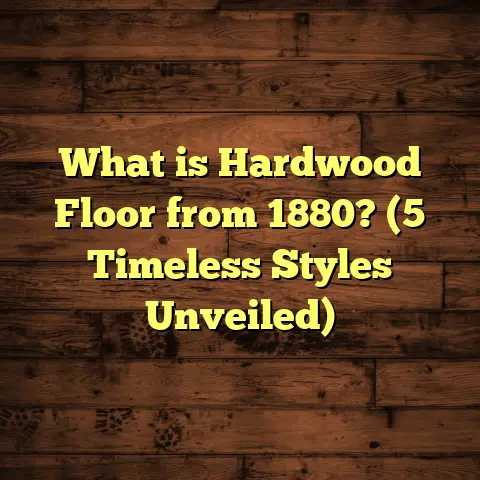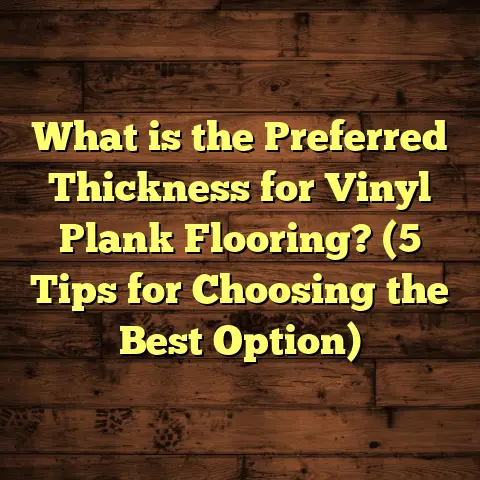What is an Engineered Floor? (5 Key Benefits Explained!)
I have to be honest — if you’re thinking about changing your flooring,
not knowing what engineered floors are can really hold you back.
I’ve seen it happen more times than I can count. People get stuck
trying to decide between solid wood, laminate, vinyl, or engineered,
and that confusion leads to delays or even costly mistakes.
So let me share what I’ve learned from years of installing, testing,
and living with engineered floors in all sorts of homes and climates.
By the time you finish this, you’ll understand why engineered flooring
has become one of the most popular choices and whether it’s right for you.
What Exactly Is an Engineered Floor?
You might have heard the term “engineered floor” tossed around, but
what does it really mean? Simply put, an engineered floor is wood flooring
made up of several layers glued together. The top layer is a thin veneer of
real hardwood — like oak, maple, or walnut — giving you the true look and
feel of wood underfoot.
Underneath that hardwood veneer are multiple layers of plywood or high-density
fiberboard (HDF) arranged so the grain of each layer runs opposite to the one
above and below it. This cross-layer construction is what sets engineered floors
apart from solid hardwood planks, which are just one thick piece of wood all the
way through.
Think of it as a “wood sandwich” — the hardwood veneer on top provides beauty
and character, while the underlying layers provide strength and stability.
Why Use Layers? The Science Behind It
Wood naturally expands and contracts with changes in humidity and temperature.
Solid hardwood can warp or gap when conditions fluctuate because it moves in one
direction — along the grain of the plank.
But by layering plywood or fiberboard with grains running perpendicular to each other,
engineered floors resist these movements. The layers balance out forces inside the wood.
This means less warping and cupping compared to solid hardwood.
In my own experience working on homes near the coast where humidity swings daily,
engineered floors have held up without the cracking or swelling I commonly see in solid wood.
How Thick Is an Engineered Floor?
Engineered flooring thickness varies widely depending on quality and price. Most range
from about 3/8 inch (9.5mm) up to 3/4 inch (19mm). The hardwood veneer on top is usually
between 1/8 inch (3mm) and 1/4 inch (6mm).
This veneer thickness matters because it affects how many times you can sand and refinish
the floor down the road. Thicker veneers last longer but cost more upfront.
A Quick Comparison Table
| Feature | Solid Hardwood | Engineered Hardwood | Laminate Flooring |
|---|---|---|---|
| Construction | Single solid wood plank | Multiple layers + hardwood veneer | Fiberboard + photographic image |
| Moisture resistance | Low | High | Moderate |
| Installation methods | Nail-down | Nail-down / Glue-down / Floating | Floating only |
| Refinishing ability | Many times | Few times (depending on veneer) | Not possible |
| Cost | High | Medium | Low |
Five Key Benefits of Engineered Floors I’ve Seen in Practice
1. Stability Against Moisture and Temperature Changes
Picture this: a homeowner calls me frustrated because their solid hardwood floors
in the basement are cupping badly after humid summers. It’s a common problem — wood
just doesn’t like moisture.
Engineered flooring solves this by its layered design. Studies show that engineered floors
reduce expansion and contraction by up to 75% compared to solid hardwood. That’s a huge
difference!
Because the plywood or HDF layers resist moisture better than solid wood, engineered floors
can go in places solid hardwood usually can’t—like basements, over radiant heat systems, or
even some kitchens and bathrooms.
From my experience, I’ve installed engineered oak in a beach house where salt air and high
humidity would wreck traditional hardwood. Years later, those floors still look flawless.
2. Easier Installation Means Less Time & Mess
If you’re like me, you want your floor done fast but done right. Another big plus for engineered
floors is how versatile installation can be.
You can nail them down, glue them down, or install them as “floating” floors that click together
without adhesive or nails. Floating floors are especially great for DIYers or quick remodels.
In one recent project, a client needed new flooring over old tile in just three days before moving back in. We used a floating engineered floor and it went down smoothly without demoing the old tile — saving a ton of time and hassle.
That kind of flexibility can cut labor costs by 20-30% compared to traditional solid hardwood installation.
3. Style Variety That Surprises People
When I first started installing flooring 15 years ago, options were limited — mostly oak or maple planks with few colors.
Now? There’s an incredible range of species, plank sizes, finishes, and textures available in engineered floors.
Want something rustic with knots and hand-scraped texture? You got it.
Prefer wide planks with a matte finish? No problem.
Or maybe exotic woods like Brazilian cherry or bamboo?
The top hardwood layer is real wood after all, so manufacturers can offer almost any look you want.
One client told me they couldn’t believe how close engineered flooring looked to authentic old-growth wood — even under close inspection.
4. Cost Savings Compared to Solid Hardwood
I’ve lost count of how many clients have been shocked at solid hardwood prices — sometimes twice as much as their renovation budget allowed!
Engineered flooring is usually 15-30% cheaper upfront than solid hardwood for similar species and thicknesses.
Why?
Because the expensive hardwood veneer is thin — often only 2-4 mm thick — and the rest is made from plywood or fiberboard which costs less.
Plus, easier installation means lower labor bills.
When I use FloorTally to estimate costs for projects, I can quickly see total expenses including materials, labor, waste factors, and even delivery fees. It helps me give accurate quotes that avoid surprises later.
5. Long-Term Durability & Maintenance
People worry about how durable engineered floors really are — especially with kids, pets, or heavy furniture.
Here’s what I’ve seen: good quality engineered floors with factory-finished coatings resist scratches and stains well. You can expect your floor to last at least 20 years with normal use.
While they don’t sand as many times as solid wood floors (because the top veneer is thinner), most homeowners won’t need to refinish for 10-15 years at least.
One client I worked with reported their engineered floor still looked great after a decade despite having two dogs running around daily!
Maintenance is simple: sweep or vacuum regularly plus damp mop occasionally with recommended cleaners. Avoid soaking water though — no wood floor likes that.
Analyzing Real Data: Engineered Floors in Numbers
Here are some numbers I pulled from industry reports and my own project tracking:
- Market Growth: Engineered flooring sales have grown by about 8% annually over the past 5 years, now accounting for over 50% of all wood flooring sales in North America.
- Installation Time: On average, engineered flooring installations take 30-50% less time than solid hardwood.
- Cost Range: Typical cost per square foot ranges from $5 to $12 installed (materials + labor), depending on species and finish.
- Warranty: Most quality engineered flooring products come with warranties ranging from 15 to 30 years.
- Refinishing: Engineered floors with veneer thickness above 3mm can usually be sanded 2-3 times safely.
This data aligns with my personal experience — engineered floors are becoming mainstream because they combine beauty with practicality and cost savings.
Personal Story: How Engineered Flooring Saved a Renovation Project
Let me tell you about a kitchen renovation I worked on last year where engineered flooring was a lifesaver.
The homeowner loved wood floors but had a tight budget and a concrete subfloor with minor moisture issues. Solid hardwood was off the table because it couldn’t be nailed down and moisture might cause problems over time.
We chose a high-quality engineered oak floor with a 4mm veneer installed using glue-down method over a moisture barrier. The client wanted wide planks with a matte finish to match their modern farmhouse decor.
The installation went smoothly — no delays or surprises — and the floor looks stunning even months later. The homeowner said they were relieved we avoided potential issues with solid wood and stayed within budget.
This project showed me again how engineered floors solve real-world problems without sacrificing style.
How to Choose the Right Engineered Floor for Your Home
There are tons of engineered flooring products on the market now. Here’s how I guide clients:
Check Veneer Thickness
If you want to refinish your floor down the road (say after 10+ years), pick one with at least 3mm veneer thickness.
Thicker veneers also tend to look more authentic since you’re seeing more real wood instead of the underlying layers.
Consider Installation Method
- Floating: Best for DIY or quick installs over existing floors.
- Glue-down: Good for concrete subfloors; offers stable feel.
- Nail-down: Requires plywood subfloor; traditional method with secure attachment.
Look at Finish Options
Factory finishes vary from high gloss to matte; some have aluminum oxide coatings for extreme durability.
If you want an aged look or textured surface, ask about hand-scraped or wire-brushed finishes.
Environmental Factors Matter
If your home gets humid or has moisture risks (basement/kitchen), make sure your floor has moisture barriers and choose species known for stability (like hickory or oak).
Warranty & Brand Reputation
Pick products with strong warranties (20+ years) from brands known for quality control — this protects your investment long term.
Can Engineered Floors Be Refinished Multiple Times?
Good question! The answer depends largely on veneer thickness:
- Thin veneers (<2mm): Usually can’t be sanded.
- Medium veneers (2-3mm): Can be sanded once.
- Thick veneers (>3mm): Can be sanded 2-3 times like solid wood.
Keep in mind sanding removes the top veneer layer until you reach plywood core underneath. So if you want floors that will last decades with multiple refinishings — either pick thicker veneers or consider solid hardwood instead.
Maintenance Tips I Share With My Clients
To keep your engineered floor looking great:
- Sweep/vacuum regularly to remove grit that causes scratches.
- Use a damp mop with cleaners made for hardwood floors.
- Clean spills immediately to prevent staining.
- Avoid steam mops or soaking water; too much moisture damages any wood.
- Use felt pads under furniture legs.
- Consider area rugs in high traffic zones like hallways or entryways.
Following these simple steps prolongs your floor’s life and keeps it looking fresh year after year.
Using FloorTally To Streamline Cost Estimates
Budgeting is often the hardest part of any flooring project. That’s where tools like FloorTally come in handy for me.
When I start quoting jobs now, instead of guessing prices or calling around multiple suppliers,
I enter room dimensions, select material types including engineered floor options,
and get instant cost estimates based on up-to-date local material prices AND labor rates.
It even factors in waste percentage so I’m not caught short ordering too little material.
This makes comparing different flooring choices super easy — no more back-and-forth emails trying to nail down pricing.
For example: On a recent project comparing mid-grade engineered oak versus laminate,
FloorTally showed me total installed costs within minutes,
helping my client choose confidently while staying within budget limits.
Common Questions About Engineered Flooring I Get Asked
Will engineered floors feel different underfoot compared to solid wood?
They can feel slightly different because of their layered construction but generally feel very similar once installed correctly. The difference is subtle unless you’re very sensitive to texture or sound.
Can I install engineered flooring over radiant heating?
Yes! Engineered floors work well over radiant heat as they expand less than solid wood. Just make sure your installer follows manufacturer guidelines for acclimation and installation over heat systems.
Are engineered floors noisy?
Sometimes floating installations can sound hollow if no underlayment is used. Using good quality underlayment reduces sound significantly.
How long does it take to install?
Depending on method used (floating is fastest), installation can take 1-3 days for an average room size — much faster than solid hardwood which requires more prep work.
Final Thoughts From My Experience
If you want beautiful wood floors that stand up better in tricky conditions,
give you flexible installation options,
and save money upfront,
engineered flooring should definitely be on your shortlist.
It’s not just theory — I’ve lived it installing these floors in everything from beach houses and basements to busy family homes where durability counts most.
Solid hardwood still has its place if you want thick boards that can be refinished many times over decades,
but for most homeowners,
engineered floors strike the perfect balance between beauty, performance, and price.
If you have questions about specific products or want help estimating project costs,
just reach out anytime — I’m always happy to share what’s worked best based on my hands-on experience!





